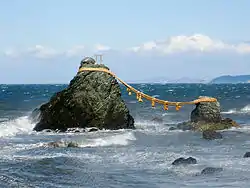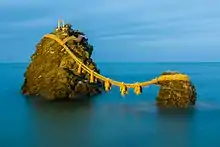Meoto Iwa
Meoto Iwa (夫婦岩), or the Married Couple Rocks, are two rocky stacks in the sea off Futami, Mie, Japan. They are joined by a shimenawa (a heavy rope of rice straw) and are considered sacred by worshippers at the neighboring Futami Okitama Shrine (Futami Okitama Jinja (二見興玉神社)). According to Shinto, the rocks represent the union of the creator of kami, Izanagi and Izanami. The rocks, therefore, celebrate the union in marriage of man and woman. The rope, which weighs over a ton, must be replaced several times a year in a special ceremony. The larger rock, said to be male, has a small torii at its peak.


At dawn during the summer, the sun appears to rise between the two rocks. Mount Fuji is visible in the distance. At low tide, the rocks are not separated by water.
Okitama Shrine is dedicated to Sarutahiko Ōkami and imperial food goddess Ukanomitama. There are numerous statues of frogs around the shrine. The shrine and the two rocks are near the Grand Shrine of Ise, the most important location of purification in Shinto.
Influence
American composer Roger Reynolds took reference to the form of Meoto Iwa in Futami, where he visited in 1966, while composing the first movement Futami ga Ura of his Symphony[Myths] (1990). Divided into 3 sections, the first and the last with "densely stratified texture" represent Izanagi and Izanami rocks respectively, and the middle section represents the space in-between.[1]
References
| Wikimedia Commons has media related to Meoto-iwa. |
- Summar, Sarah Page (December 2012). Fidget, Sway, and Swerve: Three Works Inspired by Movement from the Intricate Maneuvers Series (PDF) (PhD). University of North Texas.
- Japan-guide
- A Day Tripper's Guide to Ise and Toba Japanzine By Zack Davisson